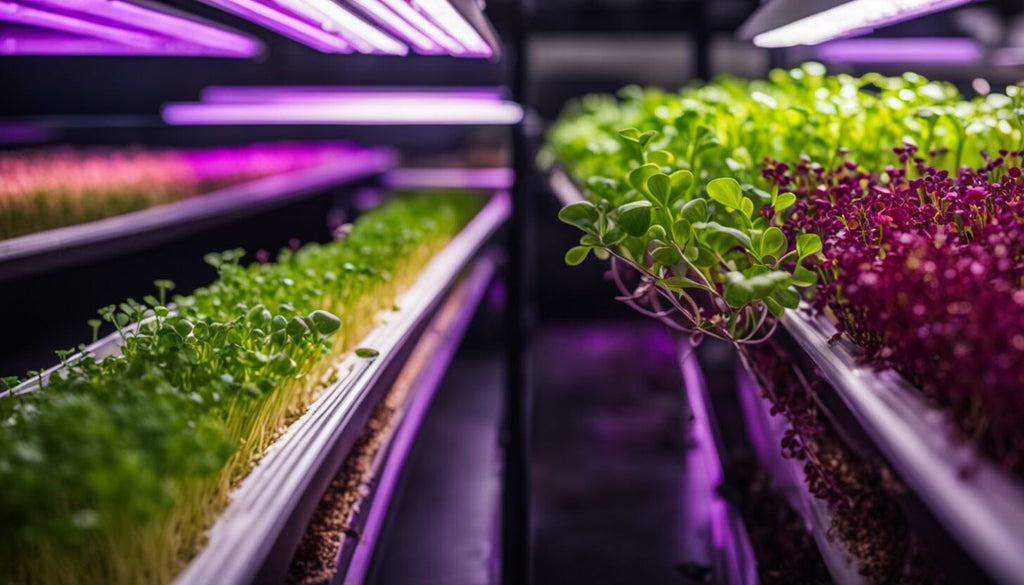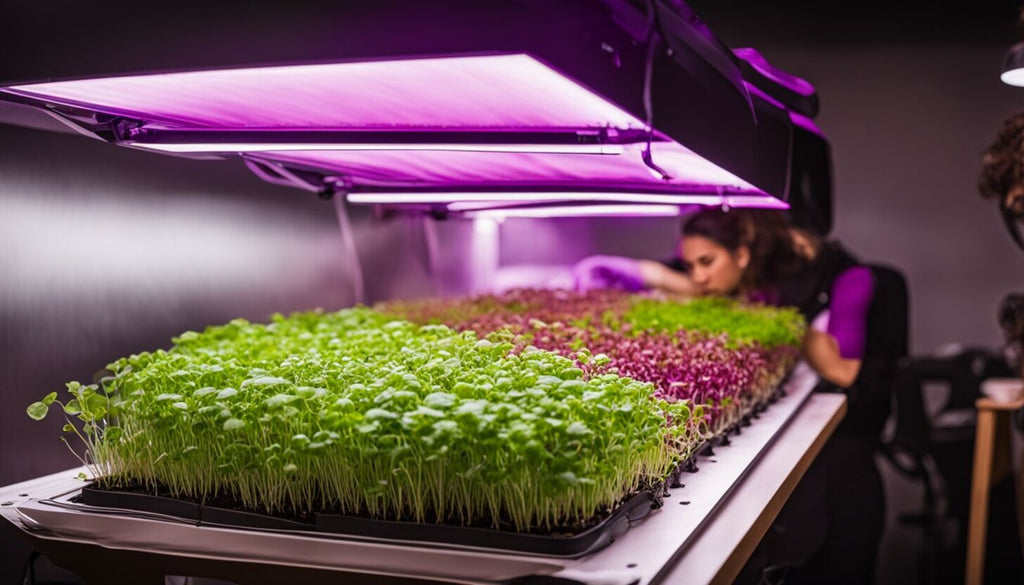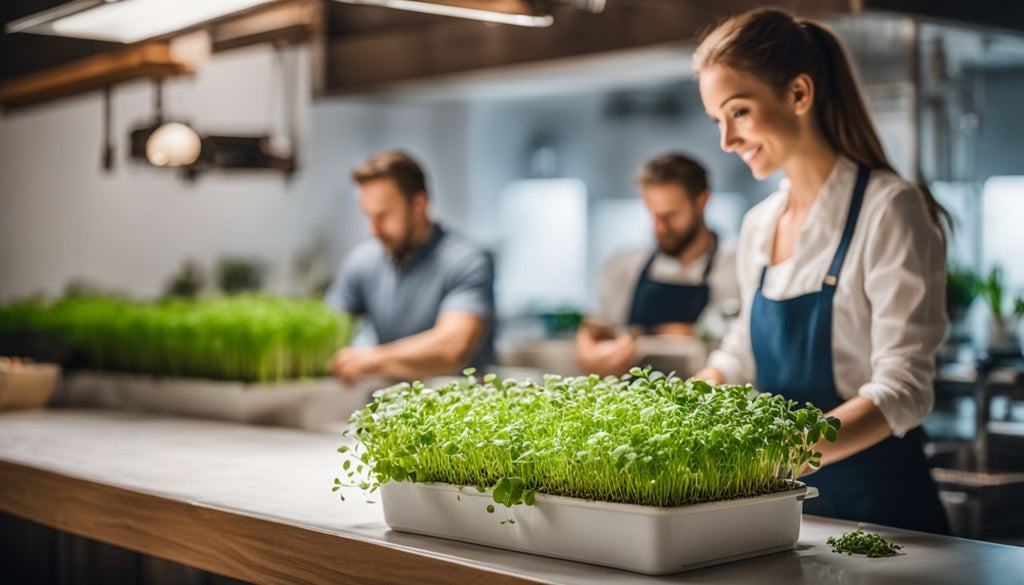Ultimate Guide: How to Successfully Grow Microgreens Hydroponically
Growing microgreens hydroponically presents an efficient and sustainable method for cultivating nutritious greens in a controlled environment, free from soil and with minimal space. This guide outlines the essential steps and best practices to achieve vibrant and healthy microgreen harvests through hydroponic gardening.
By focusing on selecting the right seeds, preparing the hydroponic system, optimizing water nutrients, and ensuring proper light and temperature conditions, gardeners of all levels can successfully produce microgreens.
This method not only accelerates growth compared to traditional soil-based gardening but also reduces water usage and eliminates the need for pesticides, offering a clean and eco-friendly alternative.
Understanding Microgreens

Microgreens are young vegetables that pack a flavorful and nutritional punch. They grow from the seeds of vegetables and herbs, reaching their harvestable size in just 7 to 10 days.
These tiny plants offer a wide variety of tastes, making them a favorite for adding zest to salads, sandwiches, and other dishes. Unlike mature plants, microgreens require minimal space and can be grown indoors year-round or outdoors during warm seasons.
Growing microgreens is the cleanest and easiest using hydroponic systems. This method eliminates the need for soil, reducing mess and pests. Proper lighting ensures these little greens thrive. With the right setup, you can enjoy fresh microgreens anytime, giving your meals an extra burst of flavor and nutrition.
Step-by-step Guide to Growing Microgreens Hydroponically

Prepare the water by adjusting its pH level. Set up the grow mat and plant the seeds carefully.
1. Preparing the Water
To prepare the water for hydroponic microgreens, add fertilizer to create a nutrient-rich solution. This solution will provide essential nutrients for the plants to grow without soil.
Ensure that the pH level of the water is within an optimal range, usually between 5.5 and 6.5, to support healthy growth and nutrient absorption by the microgreens.
2. Setting up the Grow Mat
After preparing the water, setting up the grow mat is crucial for successful hydroponic microgreens. Biostrate, a blend of biopolymers and natural fibers, efficiently manages water for optimal germination, growth, and harvest weight.
The mesh screens used with the grow mat can be cleaned and reused to provide long-term cost savings. Additionally, using coco-coir as a favorite hydroponic medium made from ground-up coconut husks offers excellent control over adding hydroponic nutrients.
Perlite is another commonly used medium that provides good water retention and aeration properties - contributing to robust growth.
Hydroponic growers typically find success when investing time in selecting appropriate mediums and setups, such as Biostrate mats with mesh screens or coco-coir-based alternatives like perlite.
3. Seeding Process
To begin the seeding process for hydroponic microgreens, select a shallow tray with drainage holes. Spread a thin layer of growing medium over the tray and gently press it down to create an even surface.
Sprinkle the microgreen seeds evenly across the surface, ensuring they are not too crowded. Lightly cover the seeds with a thin layer of growing medium and mist them with water using a spray bottle.
Place the tray under grow lights or in a well-lit location, maintaining proper humidity and temperature levels for germination.
4. Early Growth Care
During the early growth stage, ensure the grow medium is consistently moist but not waterlogged. Provide adequate light for 16-18 hours a day to support photosynthesis. Monitor pH levels regularly and adjust if necessary to maintain an optimal growing environment.
If using a hydroponic system, check that the water pump and drainage system are functioning properly to prevent water stagnation, which can lead to mold growth. Keep the growing area clean and free from debris to minimize pest infestations and promote healthy microgreen development.
5. Regular Growth and Maintenance
Regular maintenance involves monitoring the water's pH and nutrient levels. It also includes checking for any signs of mold or disease on the young plants. Adjusting the lighting to maintain an optimal distance from the microgreens is crucial for healthy growth.
Keeping a clean and sanitized environment around the trays helps prevent contamination. Proper watering, ensuring even distribution across all trays, is essential to support consistent growth.
6. Harvesting
Harvest your microgreens before they mature past 14 to 17 days. Use scissors to trim the microgreens directly from the grow pad or uproot the entire clump and snip off the roots. Rinse harvested microgreens thoroughly under cold water and ensure they are completely dry before use. A mild odor from the grow pad after about 10 days signals readiness for harvesting.
Remember to rinse harvested microgreens thoroughly under cold water, then dry them completely. Trim the microgreens directly from the grow pad or uproot the entire clump and snip off the roots, ideally before they reach more than 14 to 17 days of growth.
Read More: How To Grow Chive Microgreens
Why Grow Microgreens Hydroponically?

Grow microgreens hydroponically to minimize water usage, gain greater control over growth, and enjoy a clean and mess-free process.
Less Water Usage
Growing microgreens hydroponically means you use less water. This method is more efficient than traditional soil farming. In hydroponics, the water delivers nutrients directly to the plants' roots. This direct delivery system cuts down on waste and ensures plants use every drop.
Hydroponic systems can be set up to recycle water. This recycling helps in reducing the amount of new water needed. Commercial hydroponic farms also optimize their systems for minimal water loss, making it a smart choice for saving this precious resource.
Ability to Grow Anywhere
Microgreens thrive in hydroponic systems, making them perfect for urban areas or places with little space. You can set up your hydroponics system indoors, on balconies, or in tiny kitchens. This flexibility means you don't need a big garden or lots of land to start growing.
Hydroponics allows you to grow microgreens anywhere, regardless of the climate or location. Whether you live in a crowded city apartment or a small house with limited outdoor spaces, this method fits perfectly into your lifestyle. It eliminates the need for soil and opens up new possibilities for growing fresh greens all year round.
Greater Control Over Growth
Hydroponics grants precise control over microgreens' growth by regulating water and nutrient levels. Experiment with different grow mediums, such as coconut coir or perlite, to optimize growth conditions.
The choice of paper towels used in hydroponic systems can also impact crop development significantly. Perlite's water retention and aeration properties contribute to enhanced control over the growth process.
Clean and Mess-free
Enjoy a clean and mess-free growing experience with hydroponic microgreens. The use of water instead of soil reduces the potential for dirt and debris, creating a more hygienic environment for your plants.
This method also minimizes the need for cleaning up soil spills, making maintenance easier and more convenient.
By utilizing hydroponics, you can maintain a tidy and organized growing space while focusing on providing optimum care for your microgreens.
Necessary Equipment for Hydroponic Microgreens

Get the essential gear for your hydroponic microgreens setup. Equip yourself with growing trays, microgreen seeds, lights, hydroponic grow mediums, pH test kits or strips, spray bottles, and nutrients.
Growing Trays
Growers require growing trays as essential equipment for hydroponic microgreens. Pea microgreens, being robust growers, can be directly cultivated on mesh trays, offering durability and cost efficiency through reuse after cleaning.
Experimenting with various mediums such as jute, coco mats, peat moss, or vermiculite is crucial to discovering the most suitable one for individual growth needs. Moreover, employing Biostrate, a blend of biopolymers and natural fibers, resulted in superior germination and harvest weight based on experiments conducted.
Microgreen Seeds
Microgreen seeds are the start of your hydroponic microgreen journey. You can choose from a variety of seeds, including peas, radishes, arugula, and kale. Pea microgreens flourish when grown on mesh trays due to their robust nature.
Biostrate, made from biopolymers and natural fibers, efficiently manages water for optimal germination and growth.
Start by selecting high-quality organic seeds to ensure successful growth. Before planting your microgreen seeds in the hydroponic system, make sure they are clean and free from debris.
Lights
When it comes to growing microgreens hydroponically, the right lighting is crucial for successful growth. Full spectrum LED grow lights are ideal as they mimic natural sunlight and promote robust plant development.
Light is more critical than temperature for microgreens' growth, so ensure your setup provides consistent and adequate light exposure.
Adjustments to the distance and duration of grow lights may be necessary for crops sensitive to light. Monitor the light levels closely, as inadequate or excessive lighting can hinder growth.
Hydroponic Grow Mediums
Once you have your hydroponic grow lights in place, the next essential component for successful microgreen growth is the choice of grow medium. Biostrate, a biopolymer and natural fiber blend, has proven to result in optimal germination, growth, and harvest weight.
Hemp grow mats excel in water retention but can lead to germination issues and mold if over-watered. Perlite, commonly used for tomatoes, may be dusty, while coco-coir offers excellent control over nutrient addition.
pH Test Kit or Strips
pH test kits or strips are vital tools for hydroponic microgreen growers. They measure the acidity or alkalinity of the nutrient solution, ensuring optimal growth. Maintaining the right pH level is crucial, as it allows plants to absorb nutrients effectively.
These kits are readily available and offer a quick, accurate way to monitor and adjust the pH of the nutrient solution.
Spray Bottle
This simple tool plays a crucial role in providing the right amount of water to your microgreens without disturbing their delicate growing medium.
Maintaining proper humidity levels for the microgreens' growth and development is made easy with the fine mist produced by spray bottles. Additionally, these bottles can be used to apply nutrient solutions to support healthy growth and are recommended for gently rinsing the microgreens during harvesting.
Overall, they are a practical, cost-effective, and necessary tool in your hydroponic microgreen cultivation setup.
Nutrients
After ensuring the proper growth and maintenance of your hydroponic microgreens with a spray bottle, it's crucial to address their nutritional needs. Different types of nutrients play a vital role in the optimal growth of your microgreens.
The ultimate guide provides recommendations for nutrient solutions that are beneficial for successful growth, discussing essential ratios, pH levels, and supplement requirements to achieve the best results.
Ensuring the right balance of nutrients is paramount, as this directly impacts the health and development of your microgreens.
Read More: Simple Steps to Grow Sorrel Microgreens
Tips for Successful Hydroponic Microgreens Growth

To ensure successful hydroponic microgreens growth, consider the following tips:
- Use pea microgreens directly on mesh trays, as they are strong growers and thrive in this setup.
- Pay attention to the brand and type of paper towels used for crop growth, as different varieties can have varying effects on the outcome, with some not being food-safe for growing.
- Ensure proper lighting and a drainage system using PVC to support successful hydroponic microgreen growth.
- Regularly monitor the pH levels of the water to maintain an optimal environment for the microgreens' development.
- Implement effective pest control measures to safeguard your microgreens from potential infestations or damage.
- Provide sufficient airflow and ventilation within your growing area to promote healthy microgreen growth and prevent issues such as mold or mildew.
- Conduct thorough research on nutrient requirements and ensure that your hydroponic system provides all essential elements for robust and healthy microgreens development.
Read More: Simple Steps to Grow Chervil Microgreens
The Basics of Hydroponics
Hydroponics lets plants grow in water instead of soil. Growers mix fresh water with a little oxygen and the right pH level to support the roots. This way, food gets directly to the plant without any dirt involved. It's like giving your plants a balanced diet that helps them grow strong and healthy.
In this system, you can use different materials, such as perlite or hemp grow mats, for root support. Biostrate is another option that combines biopolymers and natural fibers. These materials keep water flowing just right, making sure plants get what they need to thrive.
Hydroponics turns growing food into an art where everything happens in water, changing the game for gardeners everywhere.
Read More: Simple Steps to Grow Spinach Microgreens
Commercial Scale Hydroponic Microgreens
Scaling up to commercial hydroponic microgreens requires additional supplies.
Extra Supplies Needed
To successfully grow microgreens hydroponically, the following extra supplies are essential:
- Ebb and Flow System: This system allows for regular flooding and draining of the growing trays, ensuring proper hydration for your microgreens.
- Nutrient Film Technique (NFT) System: NFT systems provide a constant flow of nutrient solution to the roots of your microgreens, promoting healthy growth.
- Deep Water Culture (DWC) System: This system suspends the plant roots in a nutrient solution, providing ample oxygen and nutrients for robust growth.
- Pumps and Reservoirs: These are necessary for circulating water and nutrients throughout the hydroponic system, maintaining optimal conditions for your microgreens.
- pH Balancing Kit: It's crucial to monitor and adjust the pH levels of the nutrient solution to prevent nutrient deficiencies or toxicities in your plants.
- Proper Lighting Setup: Compact fluorescent lights (CFLs) or LED bulbs are essential for providing adequate light to support photosynthesis and healthy development.
- Clean Water Source: Ensure access to a clean and reliable water supply that is free from contaminants that may affect the quality of your microgreens.
Key Takeaways
- Growing microgreens hydroponically saves water and lets you grow fresh greens anywhere, even in small indoor spaces.
- You need specific equipment like growing trays, microgreen seeds, lights, a pH test kit or strips, a spray bottle, and nutrients to start your hydroponic garden.
- Proper lighting is crucial for microgreens; full-spectrum LED grow lights work best to mimic natural sunlight.
- Adjusting the pH level of your water between 5.5 and 6.5 is important for the plants to absorb nutrients effectively.
- You can harvest most hydroponic microgreens in about 7 to 14 days from planting, making it a quick way to add nutrition and flavor to your meals.
Conclusion
Transform your growing experience with hydroponic microgreens. Embrace the control, efficiency, and versatility of this method. Ensure success with the right equipment and follow the step-by-step guide diligently.
Let your passion for growing flourish as you embark on this rewarding journey. Elevate your dishes with nutrition-packed, flavorful microgreens grown hydroponically!
For the essential tools and equipment to get started, Canada Grow Supplies has everything you need to make your hydroponic microgreens thrive. Reach out to us for expert advice, and visit our blog for comprehensive guides and tips on hydroponic growing.
With Canada Grow Supplies by your side, you're well on your way to harvesting your very own lush, flavorful microgreens, enhancing both your garden and your table.
FAQs
What do I need to start growing microgreens hydroponically?
To start, you'll need a hydroponics system like deep water cultures or aeroponics, seeds like chia or alfalfa, and artificial lights. You won't use potting soil since this is a soilless method.
How long does it take for microgreens to germinate?
Germination times vary depending on the seed type, but generally, seeds like mustard, broccoli, and wheatgrass begin sprouting in just a few days after sowing.
Can I grow any type of microgreen hydroponically?
Yes! You can grow various types of microgreens hydroponically, including lettuce, rocket, and soybeans. Each has its own nutritional value and taste.
Why are artificial lights used in growing hydroponic microgreens?
Artificial lights or LED light bulbs provide the necessary light spectrum that helps microgreens grow strong without sunlight. They're perfect for indoor setups.
Do I need any special software to learn about growing microgreens?
While not required, online courses and YouTube videos can offer valuable guidance on optimizing your setup for optimum nutrition and yield.
Are there health considerations when eating microgreens grown this way?
Yes! While they’re packed with vitamins and micronutrients, people on blood thinning medication like warfarin should know that some greens are high in Vitamin K, which could affect their medication's effectiveness.








